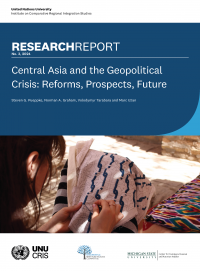Central Asia and the Geopolitical Crisis: Reforms, Prospects, Future

The Central Asian region, comprising Kazakhstan, Kyrgyzstan, Tajikistan, Turkmenistan, and Uzbekistan, is strategically significant with abundant natural resources. Its stability is crucial globally, and the multi-vector strategic policies of the five states have garnered attention.
The first section, Central Asia: Country-level Analysis, provides both a general cross-country analysis and a detailed analysis of each Central Asian country.
Kazakhstan, the largest economy, has shown consistent growth but remains a middle-income country. The manufacturing industry in Kazakhstan is comparable to the mining sector, but undernourishment remains a challenge. The government is actively investing in the agricultural sector to improve food security. Uzbekistan, despite high economic growth rates, remains among the lowest in Central Asia in terms of GDP per capita. The country’s manufacturing industry is mainly represented by low-tech production. Tajikistan has the lowest GDP per capita in the region. The country’s economy is heavily reliant on remittances from migrant workers, mainly from Russia. Kyrgyzstan has shown positive economic growth, largely driven by gold mining. The country’s main trading partners are China and Russia. Kyrgyzstan has undergone political instability and changes of government, but the situation has stabilized since 2021. The country has implemented a range of reforms, including constitutional reform and administrative reforms. Turkmenistan is the most closed country in the region, with limited access to economic data. The country’s economy is heavily reliant on the oil and gas industry.
The second section, Central Asian Regionalism: Retrospect and Prospect, places the above issues into perspective for the region.
The region’s path toward integration has been uneven, marked by periods of cooperation and fragmentation. In the aftermath of the Soviet Union’s collapse, the Central Asian states initiated integration processes, focusing on economic cooperation and shared development objectives. However, these attempts faced challenges due to varying levels of economic development, political instability, and the emergence of authoritarian regimes. Despite the obstacles, the region has witnessed renewed efforts toward integration in recent years. The countries have engaged in bilateral and multilateral formats, utilizing instruments such as the Shanghai Cooperation Organization (SCO), the Eurasian Economic Union (EAEU), and the C5+1 diplomatic platform. Kazakhstan, with its leading economy and active participation in regional initiatives, has emerged as a key driver of integration. The region’s strategic significance, including its role as a transit corridor and its proximity to major powers, has added further complexity to the integration process.
Central Asia’s future integration prospects depend on addressing several challenges, including political stability, economic disparities, and the need for sustainable development strategies. The region’s vast potential can be unlocked through deeper cooperation, resource management, and global engagement.
